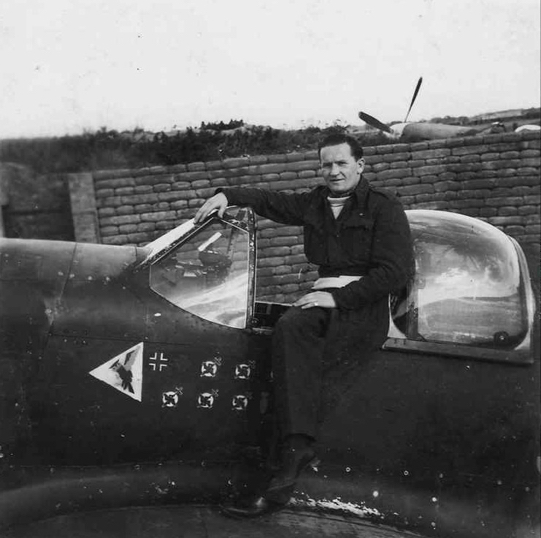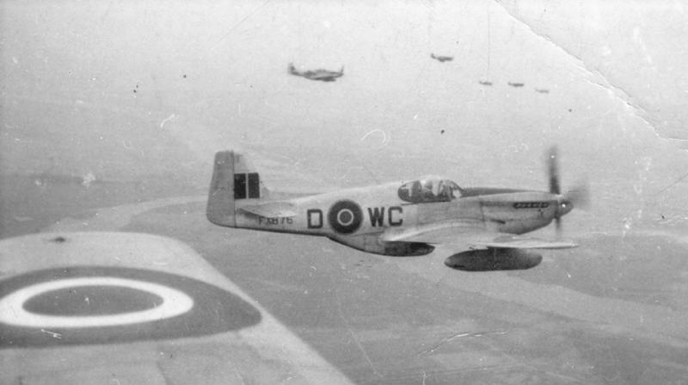Date: 2nd August 1945
Time: 11.15 a.m.
Unit: No. 309 (P) Polish Squadron.
Type: North American Mustang III
Serial No: FX876
Location: Oaksfield, Goulds Farm, Rayne, Essex, England.
Pilot: Warrant Officer. Aleksander Pietrzac (Poland) P783147 – Killed.

Alex pictured in the cockpit of his Mustang P-51 (Pietrzac)
This pilot originally served with No. 316(P) Squadron and carried out escort duties and diver patrols against the incoming V1 flying bombs. On the 12.07.1944 whilst flying Mustang III FB378 Aleksander Pietrzac attacked a V1 which exploded causing serious damage to his aircraft. Controls were lost and he had to bale out of the stricken aircraft.
Decorations include the Virtuti Militari and the Polish Cross of Valour. This is the brief account of a Polish fighter pilot who served with the Royal Air Force during WWII. In January 1943 Sgt Pietrzac was flying Spitfires at 58 O.T.U. (Operational Training Unit). Transferred to No. 316(P) Polish Squadron and flew on operations from February 1943 until March 1944 and took part in the defensive operations against the German V1 flying bombs. He joined No. 309 (P) Squadron in February 1945. Aleksander Pietrzac’s total flying time as pilot by day was 784 hours, of which 246 hours were in Mustang fighters. He became senior N.C.O. pilot of the Squadron stationed at Andrews Field and was highly thought of by his Squadron Commander. He had distinguished himself beyond the call of duty in the defence of this country during the V1 rocket attacks of 1944. He survived the air battles of World War II only to tragically lose his life in a flying accident on the 2nd August 1945 at Andrews Field.
No. 316(P) Polish Squadron and the “Flying Bombs”
Between June 13th 1944 and March 29th 1945 a total of 9,251 V1 flying bombs (known as Doodlebugs or Divers) were plotted by the Royal Observer Corps (ROC) from the 1,500 Observer Posts. Of these pilot-less monoplanes 2,419 reached London. The total number destroyed was 4,261 – 1,971 by anti-aircraft fire, 1,979 by the skilled flying of the pilots of the Royal Air Force, 278 by balloons and 33 by the Royal Navy. A total of 412 came down in the county of Essex. Sgt Aleksander Pietrzac of No. 316(P) Squadron was personally responsible for destroying 6 divers! On the 12th July 1944 Sgt Pietrzac was detailed to carry out diver patrols against the incoming tide of V1 flying bombs.
Flying Mustang III serial number FB378 Sgt Pietrzac intercepted a Diver and pressed home his attack! After several bursts of fire from his four 0.5 calibre machine guns the Diver suddenly exploded sending hot twisted debris through the air, some of which smashed into his aircraft causing serious damage to the flying controls. Sgt Pietrzac had no option but to abandon the stricken machine after control was lost. Whilst serving with No. 316 Squadron Aleksander Pietrzac carried out fighter escort duties protecting Allied bomber sorties to Germany. On two occasions Sgt Pietrzac was involved in combats with defending Messerschmitt Bf 109 fighters, the first victory was on the 14th October 1944 and the second four days later on the 18th where he claimed one destroyed and one shared. His last combat was on the 23rd March 1945 on this occasion he claimed a Messerschmitt Me 262 jet fighter as damaged. Shortly after Aleksander Pietrzac now promoted to Warrant Officer was transferred to No. 309 Polish Squadron stationed at Andrews Field (Great Saling) Essex.
REASON FOR LOSS:
No. 309(P) Squadron 1945
1st August 1945
P-51 Mustang III with the serial No. FX 876 to workshop to undergo routine minor inspection. The airframe was built North American Aviation Inc. and its total flying time was 307 hours. All modifications affecting airworthiness except No.691 had been embodied. The engine was built by the Packard Motor Car Company, No. V 324217 and its total running time was 664 hours. Both airframe and engine had been properly maintained and serviced and both had been certified fit for flight at 0845 hours on August 2nd.

Mustang FX876 in flight (Pietrzac)
2nd August 1945
Tragedy at Andrews Field
At 10.15 hours Mustang FX 876 took off on its first flight since the inspection was completed. It should be noted that the aircraft was not test flown. The pilot W/O Pietrzac had been briefed to take part in a Squadron formation exercise which was to be followed by dive bombing practice. FX 876 was one of the first pair in the formation to leave the ground. The other member of this pair was the Squadron Commander.
Almost as soon as the two aircraft were airborne W/O Pietrzac overtook his leader and a few seconds later called him on the R/T (radio transmitter) to state that his rudder control had jammed and that he could not use starboard rudder but he could still apply port rudder.
The Squadron Commander immediately ordered him to return and land and W/O Pietrzac thereupon turned away and disappeared. Some four minutes later, after the rest of the Squadron had formed up with the leader and W/O Pietrzac’s original place in the formation had been filled, FX 876 reappeared and W/O Pietrzac requested permission to rejoin, stating that his aircraft was now serviceable.
This permission was granted. Various squadron formation manoeuvres were then carried out for a period of forty minutes, during which FX 876 appeared to fly normally. Dive bombing practice then began from a height of about 12,000 feet.
The Squadron formed line astern with W/O Pietrzac as number 7. Each aircraft in turn pulled up into a stalled turn to the left and entered its dive, the instructions to each pilot being that recovery should be affected at 5,000 ft. FX 876 entered its dive in exactly the same way as had those aircraft ahead of it but instead of pulling out at 5,000 ft its dive was seen by the pilot of number 8 aircraft which was close behind, to become suddenly steeper until it reached an angle over the vertical. Number 8 realised that something was amiss and endeavoured to follow FX 876 in order to keep it under observation.
The pilot of number 8 stated that when FX 876 started to dive over the vertical he also noticed that it was side-slipping to the left and he declared that he had great difficulty in following it. He stated that he then saw it carry out an aileron turn one and a half times round and the pulled out of its dive inverted at an altitude well under 100 feet. The pilot of number 8 lost sight of it at this point because his own airspeed was over 500 m.p.h. I.A.S. and his height was only around 3,000 ft. He therefore had his attention fully occupied in recovering normal flight, which he did by using his tail trim after unsuccessfully trying to ease back the stick. He then caught sight of FX 876 again. It was still inverted and climbing. Although he himself was still travelling at very high speed FX 876 overtook him and nosed over into a dive which continued to the ground.It subsequently transpired that W/O Pietrzac had fallen out of his aircraft whilst it was inverted and travelling at tremendous speed across
Andrews Field Aerodrome at a height of only about 20 ft. He had undoubtedly been thrown from the cockpit under high negative “g”. The fact that no pieces of the cockpit hood were found away from the main wreckage suggested that the hood was open when the pilot was ejected W/O Pietrzac was killed instantly. The funeral of Aleksander Pietrzac was held at 3.00 p.m on the 7th August at Epping Cemetery.
Examination at the scene of the accident at Gould Farm, Rayne, Essex showed that the aircraft had struck the ground whilst diving vertically at very high speed. The force of the impact and subsequent fire which broke out reduced the wreckage to such a condition that no technical evidence was obtainable from it except that it was possible to state that there had been no structural failure of any major component in flight.
The engine had penetrated the ground to a depth of about 12 ft and had been smashed by the force of impact into three main portions. There were indications that it had been running at high speed when the aircraft hit the ground.

Aleksander Pietrzac’s last resting place, Epping Cemetery 18.08.200
 cc
cc
David King pays his respects at the grave of this pilot, our mascot “Poppydog” did not want to be left out! (Brownless)
Burial details: Bury Lane Cemetery, Epping, Essex . Row Z. Grave 11
Research by Melvin Brownless & David King of the Remembrance Society 2007


The British Library is preserving this site for the future in the UK Web Archive at www.webarchive.org.uk All Aircrew Remembered on our Remembrance pages, are therefor not just remembered here, but also subsequently remembered and recorded as part of our nation’s history
and heritage at The British Library.

